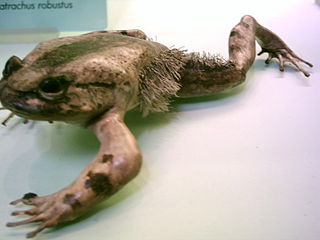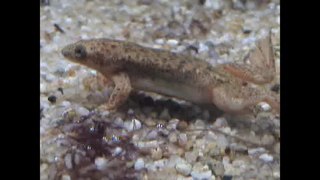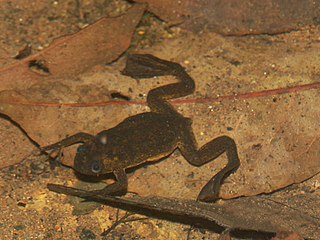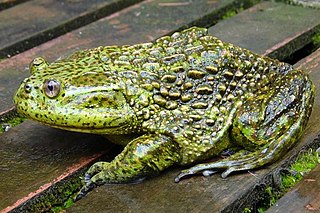
Amphibians are four-limbed and ectothermic vertebrates of the class Amphibia. All living amphibians belong to the group Lissamphibia. They inhabit a wide variety of habitats, with most species living within terrestrial, fossorial, arboreal or freshwater aquatic ecosystems. Thus amphibians typically start out as larvae living in water, but some species have developed behavioural adaptations to bypass this.

The African clawed frog, also known as simply Xenopus, African clawed toad, African claw-toed frog or the Platanna) is a species of African aquatic frog of the family Pipidae. Its name is derived from the short black claws on its feet. The word Xenopus means 'strange foot' and laevis means 'smooth'.

The Australian green tree frog, also known as simply green tree frog in Australia, White's tree frog, or dumpy tree frog, is a species of tree frog native to Australia and New Guinea, with introduced populations in the United States and New Zealand, though the latter is believed to have died out. It is morphologically similar to some other members of its genus, particularly the magnificent tree frog (R. splendida) and the white-lipped tree frog (R. infrafrenata).

African dwarf frog is the common name for members of Hymenochirus, a genus of aquatic frog native to parts of Equatorial Africa. They are common in the pet trade and are often mistaken for the African clawed frog, a similar-looking frog in the same family. African dwarf frogs are also known as dwarf clawed frogs. Their common name is obtained from their place of origin and the claws on their hind legs.

The African clawless otter, also known as the Cape clawless otter or groot otter, is the second-largest freshwater otter species. It inhabits permanent water bodies in savannah and lowland forest areas through most of sub-Saharan Africa. It is characterised by partly webbed and clawless feet, from which their name is derived. The word 'aonyx' means clawless, derived from the prefix a- ("without") and onyx ("claw/hoof").

A freshwater aquarium is a receptacle that holds one or more freshwater aquatic organisms for decorative, pet-keeping, or research purposes. Modern aquariums are most often made from transparent glass or acrylic glass. Typical inhabitants include fish, plants, amphibians, and invertebrates, such as snails and crustaceans.

The hairy frog also known as the horror frog or Wolverine frog, is a Central African species of frog in the family Arthroleptidae. It is typically considered monotypic within the genus Trichobatrachus, but based on genetic it should be included in Astylosternus instead. Its common name refers to the somewhat hair-like structures on the body and thighs of the breeding male.

Sclerophrys regularis, commonly known as the African common toad, square-marked toad, African toad, Egyptian toad, African bouncing toad and Reuss's toad, is a species of toad in the family Bufonidae. It is found widely in the Subsaharan Africa, with its range extending to the oases in Algeria and Libya as well as to northern Nilotic Egypt. Specifically, it is found in Angola, Benin, Burkina Faso, Cameroon, Cape Verde, Central African Republic, Chad, Republic of the Congo, Democratic Republic of the Congo, Ivory Coast, Egypt, Ethiopia, Gabon, Ghana, Guinea, Guinea-Bissau, Kenya, Liberia, Mali, Niger, Nigeria, Rwanda, Senegal, Sierra Leone, Sudan, and Uganda.

The Cameroon forest tree frog is a species of frog in the family Arthroleptidae. It is found in southern Nigeria, Cameroon, Equatorial Guinea, and Gabon. It is expected to occur in southwestern Central African Republic and in the Republic of the Congo, but no records have been confirmed from those countries.
Hymenochirus boulengeri, also known as eastern dwarf clawed frog, is a species of frog in the family Pipidae. It is endemic to northeastern Democratic Republic of the Congo where it is only known from two localities. It is presumably ecologically similar to Hymenochirus boettgeri, an aquatic frog that occurs in still, shaded water in lowland rainforest, and in pools by slow-flowing rivers. Threats to this little-known species are unknown.
Hymenochirus curtipes, also known as western dwarf clawed frog, is a species of frog in the family Pipidae. It is found in western Democratic Republic of the Congo and adjacent Republic of the Congo. It is likely to occur in the southernmost Central African Republic.

Hymenochirus feae, also known as Gaboon dwarf clawed frog, is a species of frog in the family Pipidae. It is endemic to Gabon and is only known with certainty from its type locality on the coast of central Gabon. The specific name feae honors Leonardo Fea, an Italian explorer, zoologist, and naturalist.

Merlin's dwarf gray frog, or Merlin's clawed frog, is a species of frog in the family Pipidae. It is monotypic within the genus Pseudhymenochirus. It is found in southern Guinea-Bissau, western Guinea, and southern Sierra Leone.
Xenopus boumbaensis, the Mawa clawed frog, is a species of frog in the family Pipidae. It is known from a few localities in central and south-eastern Cameroon, and from north-western Republic of Congo and extreme south-western Central African Republic; it probably occurs more widely in the central African forest belt, but identification is difficult: it is one of the cryptic species that resemble Xenopus fraseri, from which it can be distinguished by chromosome number (2n=72) and a male advertisement call of a single note.

The Lake Oku clawed frog is a species of frog in the family Pipidae, endemic to Lake Oku, a small crater lake in northwest Cameroon. It is a small, dark-coloured, fully aquatic frog with a length of 28 to 36 mm, males being slightly smaller than females. The International Union for Conservation of Nature has rated this frog as "critically endangered" on the basis of its small area of occurrence at a single location, and the possibility that introduction of non-native fish into the lake could cause the frog to be wiped out.
Aubria masako is a species of frog in the family Pyxicephalidae. It is found in southeastern Cameroon, eastern Gabon, southwestern Central African Republic, northern Republic of the Congo, and eastward to the central Democratic Republic of the Congo, with one (doubtful) record from Angola; it might occur in Equatorial Guinea. Common names Masako ball frog and Masako fishing frog have been coined for this species. Whether it is distinct from Aubria subsigillata has been debated, but at present it is treated as a valid species.
Ptychadena trinodis is a species of frog in the family Ptychadenidae. Its common name is Dakar grassland frog. It is widely distributed in West and Middle Africa, and following the International Union for Conservation of Nature (IUCN), occurs in Benin, Cameroon, Central African Republic, Chad, Democratic Republic of the Congo, Gambia, Ghana, Guinea, Ivory Coast, Mali, Mauritania, Nigeria, Senegal, and Togo. Further, records are missing from Guinea-Bissau, Burkina Faso, Niger, South Sudan, and Sudan, but it is presumed to be present in these countries too.

The African bullfrog, also known as the Giant bullfrog or the South African burrowing frog, is a species of frog in the family Pyxicephalidae. It is also known as the pixie frog due to its scientific name. It is found in Angola, Botswana, Kenya, Malawi, Mozambique, Namibia, South Africa, Tanzania, Uganda, Zambia, Zimbabwe, and possibly the Democratic Republic of the Congo. It has been extirpated from Eswatini. It has long been confused with the edible bullfrog, and species boundaries between them, including exact range limits, are not fully understood. Additionally, P. angusticeps of coastal East Africa only was revalidated as a separate species in 2013.

Calyptocephalella is a genus of frogs in the family Calyptocephalellidae. It is represented by a single living species, Calyptocephalella gayi, commonly known as the helmeted water toad, Chilean helmeted bull frog, or wide-mouthed toad. Additionally, there are a few extinct species that are only known from Late Cretaceous and Paleogene fossil remains from Patagonia in South America and the Antarctic Peninsula. The helmeted water toad living today is aquatic to semi-aquatic, and found in deep ponds and reservoirs in central Chile and possibly adjacent west-central Argentina.















